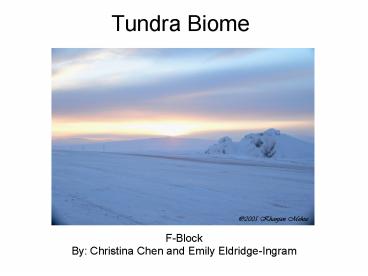Tundra Biome - PowerPoint PPT Presentation
1 / 10
Title:
Tundra Biome
Description:
Tundra Biome F-Block By: Christina Chen and Emily Eldridge-Ingram Temperature Tundra regions are extremely cold throughout the year, averaging at -28 Precipitation ... – PowerPoint PPT presentation
Number of Views:620
Avg rating:3.0/5.0
Title: Tundra Biome
1
Tundra Biome
- F-Block
- By Christina Chen and Emily Eldridge-Ingram
2
Temperature
- Tundra regions are extremely cold throughout the
year, averaging at -28
3
Precipitation
- Tundra regions receive very little precipitation,
only 15-25 cm annually.
4
Location
- found beyond the tree line
- occupy 11,563,300 square km (20 of Earth's land
surface) - found between 60 and 70 degrees latitude
- most tundra regions are near the North Pole
5
General Description
- harsh environment that sustains little life (low
biodiversity) - a layer of permafrost in the subsoil
- lack of tall plants
- experience only two seasons, summer and winter
- most precipitation during the summer
- animal species include caribou, arctic hares, and
snowy owls - no significant human activity
6
Plants
- arctic moss
- aquatic plant inhabiting bottoms of lake beds
- stores nutrients during winter to produce leaves
during summer - protected from wind and cold air by low height
and water
- tufted saxifrage
- blankets the ground
- has short hollow stems
- leaves are covered with silky hair for insulation
- well-developed root system for storing
carbohydrates
7
Animal Life
- arctic fox
- scavenge for necessary nutrients
- burrow underground for shelter
- bushy tail and fur-padded feet conserve body heat
- developed sharp predatory senses over time to
hunt prey
- snowy owl
- hunt arctic animals such as voles and lemmings
- hunt during the day
- thick plumage
- heavily feathered taloned feet
- their white feathers camouflage them in tundra
regions
8
Two Abiotic Factors
- low temperature
- only hardy plants can survive
- most animals have thick fur
- insignificant human activity
- scarce precipitation
- plants are not as nourished
- mostly shrubs, mosses, and lichens
- few large grazing animals
9
Ecological Disturbances
- global warming has recently melted some of the
permafrost in tundra areas - warmer climate will cause tundras to sustain more
vegetation - growth of taller shrubs
- this will increase risk of fire and warmth of
climate - this will reduce dominance of mosses and lichens
and maybe introduce trees to the landscape
10
Bibliography
- http//www.blueplanetbiomes.org/tundra_plant_page.
htm (arctic moss and tufted saxifrage) - http//www.marietta.edu/biol/biomes/tundra.htm
(general information) - http//www.blueplanetbiomes.org/tundra_animal_page
.htm (arctic fox and snowy owl) - http//www.newscientist.com/article/dn13408-global
-warming-may-raise-tundra-wildfire-risk.html
(ecological concerns) - http//www.arthurmag.com/tags/trees/
mossicechunk.jpg (moss picture) - http//biomef.wikispaces.com/Tundra (tundra
picture) - http//animals.nationalgeographic.com/animals/mamm
als/arctic-fox/ (arctic fox picture) - http//www.blueplanetbiomes.org/tundra.htm tundra
location map 001 gif (location picture) - http//images.nationalgeographic.com/wpf/media-liv
e/photos/000/007/cache/snowy-owl_714_600x450.jpg
(snowy owl picture) - http//www.blueplanetbiomes.org/images/tufted_saxi
frage.jpg (tufted saxifrage picture) - http//scioly.org/w/images/6/65/Tundra_Climagraph.
jpg (temp graph) - http//earthobservatory.nasa.gov/Experiments/Biome
/Images/precipsouthafrica.gif (rain graph)































